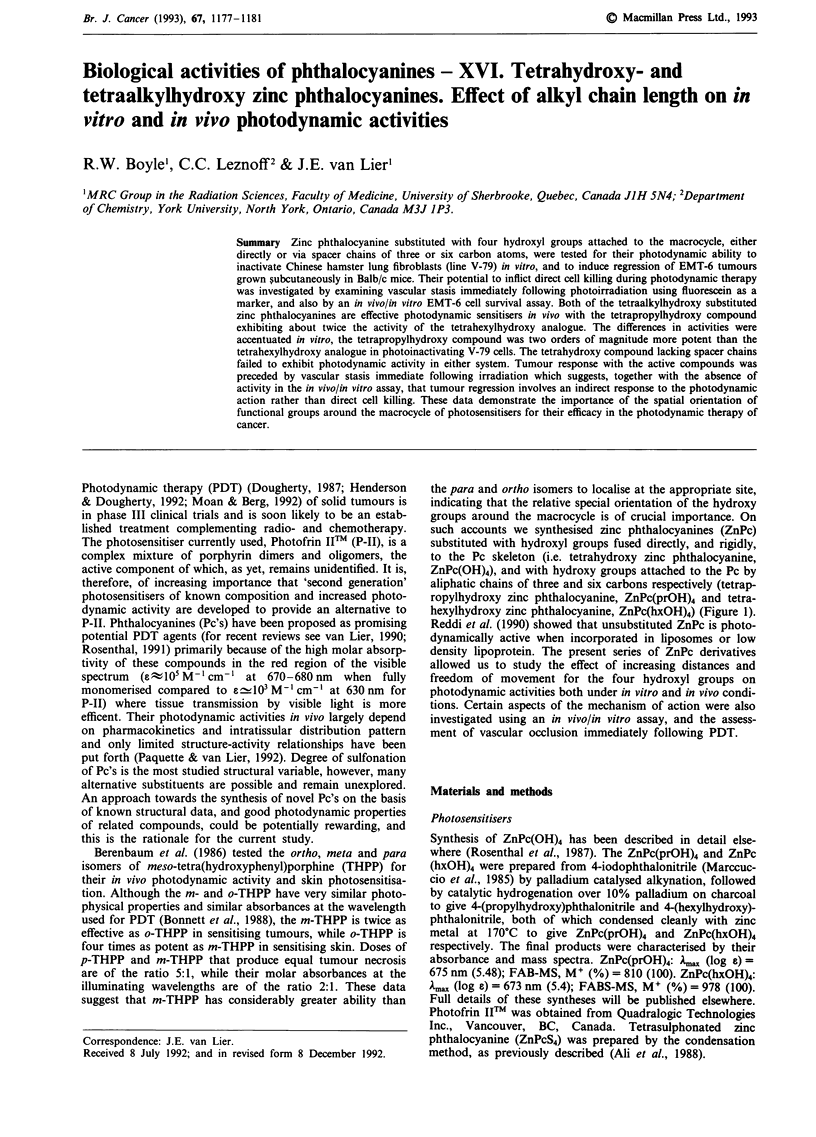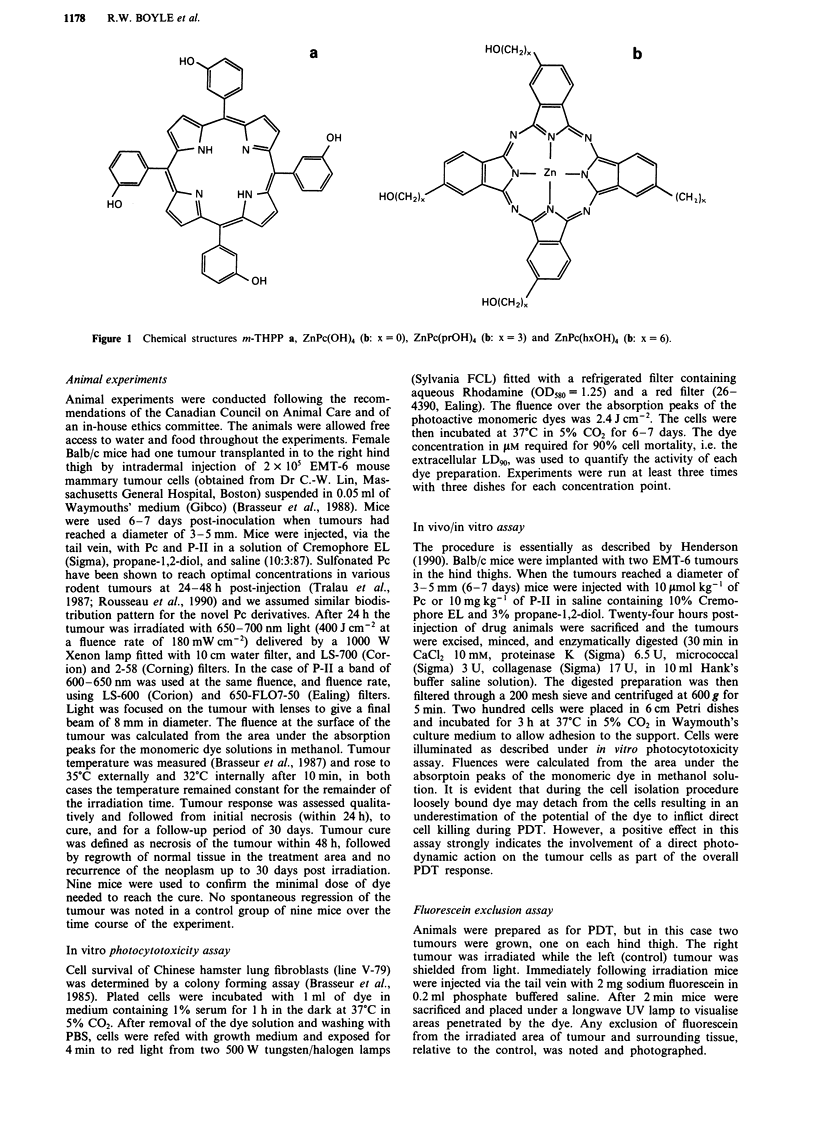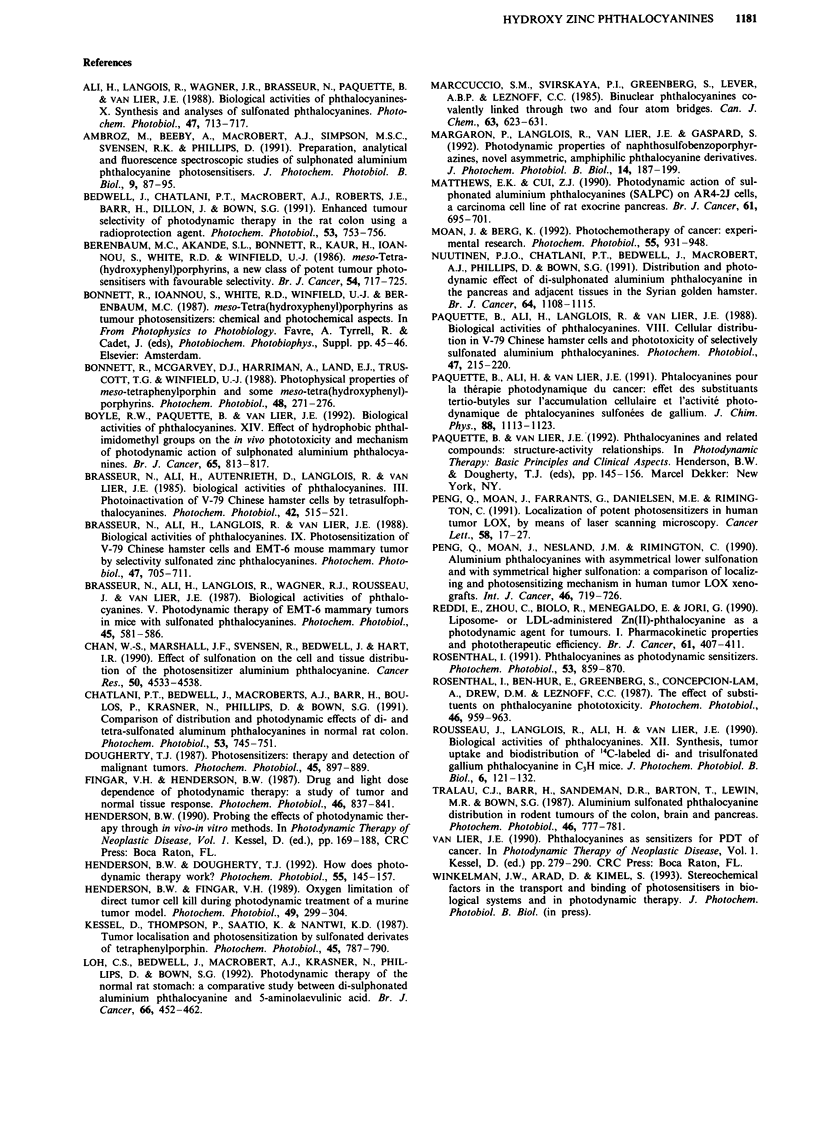Abstract
Zinc phthalocyanine substituted with four hydroxyl groups attached to the macrocycle, either directly or via spacer chains of three or six carbon atoms, were tested for their photodynamic ability to inactivate Chinese hamster lung fibroblasts (line V-79) in vitro, and to induce regression of EMT-6 tumours grown subcutaneously in Balb/c mice. Their potential to inflict direct cell killing during photodynamic therapy was investigated by examining vascular stasis immediately following photoirradiation using fluorescein as a marker, and also by an in vivo/in vitro EMT-6 cell survival assay. Both of the tetraalkylhydroxy substituted zinc phthalocyanines are effective photodynamic sensitisers in vivo with the tetrapropylhydroxy compound exhibiting about twice the activity of the tetrahexylhydroxy analogue. The differences in activities were accentuated in vitro, the tetrapropylhydroxy compound was two orders of magnitude more potent than the tetrahexylhydroxy analogue in photoinactivating V-79 cells. The tetrahydroxy compound lacking spacer chains failed to exhibit photodynamic activity in either system. Tumour response with the active compounds was preceded by vascular stasis immediate following irradiation which suggests, together with the absence of activity in the in vivo/in vitro assay, that tumour regression involves an indirect response to the photodynamic action rather than direct cell killing. These data demonstrate the importance of the spatial orientation of functional groups around the macrocycle of photosensitisers for their efficacy in the photodynamic therapy of cancer.
Full text
PDF




Selected References
These references are in PubMed. This may not be the complete list of references from this article.
- Ali H., Langlois R., Wagner J. R., Brasseur N., Paquette B., van Lier J. E. Biological activities of phthalocyanines--X. Syntheses and analyses of sulfonated phthalocyanines. Photochem Photobiol. 1988 May;47(5):713–717. doi: 10.1111/j.1751-1097.1988.tb02769.x. [DOI] [PubMed] [Google Scholar]
- Ambroz M., Beeby A., MacRobert A. J., Simpson M. S., Svensen R. K., Phillips D. Preparative, analytical and fluorescence spectroscopic studies of sulphonated aluminium phthalocyanine photosensitizers. J Photochem Photobiol B. 1991 Apr;9(1):87–95. doi: 10.1016/1011-1344(91)80006-4. [DOI] [PubMed] [Google Scholar]
- Bedwell J., Chatlani P. T., MacRobert A. J., Roberts J. E., Barr H., Dillon J., Bown S. G. Enhanced tumour selectivity of photodynamic therapy in the rat colon using a radioprotective agent. Photochem Photobiol. 1991 Jun;53(6):753–756. doi: 10.1111/j.1751-1097.1991.tb09888.x. [DOI] [PubMed] [Google Scholar]
- Berenbaum M. C., Akande S. L., Bonnett R., Kaur H., Ioannou S., White R. D., Winfield U. J. meso-Tetra(hydroxyphenyl)porphyrins, a new class of potent tumour photosensitisers with favourable selectivity. Br J Cancer. 1986 Nov;54(5):717–725. doi: 10.1038/bjc.1986.232. [DOI] [PMC free article] [PubMed] [Google Scholar]
- Bonnett R., McGarvey D. J., Harriman A., Land E. J., Truscott T. G., Winfield U. J. Photophysical properties of meso-tetraphenylporphyrin and some meso-tetra(hydroxyphenyl)porphyrins. Photochem Photobiol. 1988 Sep;48(3):271–276. doi: 10.1111/j.1751-1097.1988.tb02820.x. [DOI] [PubMed] [Google Scholar]
- Boyle R. W., Paquette B., van Lier J. E. Biological activities of phthalocyanines. XIV. Effect of hydrophobic phthalimidomethyl groups on the in vivo phototoxicity and mechanism of photodynamic action of sulphonated aluminium phthalocyanines. Br J Cancer. 1992 Jun;65(6):813–817. doi: 10.1038/bjc.1992.174. [DOI] [PMC free article] [PubMed] [Google Scholar]
- Brasseur N., Ali H., Autenrieth D., Langlois R., van Lier J. E. Biological activities of phthalocyanines--III. Photoinactivation of V-79 Chinese hamster cells by tetrasulfophthalocyanines. Photochem Photobiol. 1985 Nov;42(5):515–521. doi: 10.1111/j.1751-1097.1985.tb01603.x. [DOI] [PubMed] [Google Scholar]
- Brasseur N., Ali H., Langlois R., Wagner J. R., Rousseau J., van Lier J. E. Biological activities of phthalocyanines--V. Photodynamic therapy of EMT-6 mammary tumors in mice with sulfonated phthalocyanines. Photochem Photobiol. 1987 May;45(5):581–586. doi: 10.1111/j.1751-1097.1987.tb07383.x. [DOI] [PubMed] [Google Scholar]
- Brasseur N., Ali H., Langlois R., van Lier J. E. Biological activities of phthalocyanines--IX. Photosensitization of V-79 Chinese hamster cells and EMT-6 mouse mammary tumor by selectively sulfonated zinc phthalocyanines. Photochem Photobiol. 1988 May;47(5):705–711. doi: 10.1111/j.1751-1097.1988.tb02768.x. [DOI] [PubMed] [Google Scholar]
- Chan W. S., Marshall J. F., Svensen R., Bedwell J., Hart I. R. Effect of sulfonation on the cell and tissue distribution of the photosensitizer aluminum phthalocyanine. Cancer Res. 1990 Aug 1;50(15):4533–4538. [PubMed] [Google Scholar]
- Chatlani P. T., Bedwell J., MacRobert A. J., Barr H., Boulos P. B., Krasner N., Phillips D., Bown S. G. Comparison of distribution and photodynamic effects of di- and tetra-sulphonated aluminium phthalocyanines in normal rat colon. Photochem Photobiol. 1991 Jun;53(6):745–751. doi: 10.1111/j.1751-1097.1991.tb09887.x. [DOI] [PubMed] [Google Scholar]
- Dougherty T. J. Photosensitizers: therapy and detection of malignant tumors. Photochem Photobiol. 1987 Jun;45(6):879–889. doi: 10.1111/j.1751-1097.1987.tb07898.x. [DOI] [PubMed] [Google Scholar]
- Fingar V. H., Henderson B. W. Drug and light dose dependence of photodynamic therapy: a study of tumor and normal tissue response. Photochem Photobiol. 1987 Nov;46(5):837–841. doi: 10.1111/j.1751-1097.1987.tb04856.x. [DOI] [PubMed] [Google Scholar]
- Henderson B. W., Dougherty T. J. How does photodynamic therapy work? Photochem Photobiol. 1992 Jan;55(1):145–157. doi: 10.1111/j.1751-1097.1992.tb04222.x. [DOI] [PubMed] [Google Scholar]
- Henderson B. W., Fingar V. H. Oxygen limitation of direct tumor cell kill during photodynamic treatment of a murine tumor model. Photochem Photobiol. 1989 Mar;49(3):299–304. doi: 10.1111/j.1751-1097.1989.tb04110.x. [DOI] [PubMed] [Google Scholar]
- Kessel D., Thompson P., Saatio K., Nantwi K. D. Tumor localization and photosensitization by sulfonated derivatives of tetraphenylporphine. Photochem Photobiol. 1987 Jun;45(6):787–790. doi: 10.1111/j.1751-1097.1987.tb07883.x. [DOI] [PubMed] [Google Scholar]
- Loh C. S., Bedwell J., MacRobert A. J., Krasner N., Phillips D., Bown S. G. Photodynamic therapy of the normal rat stomach: a comparative study between di-sulphonated aluminium phthalocyanine and 5-aminolaevulinic acid. Br J Cancer. 1992 Sep;66(3):452–462. doi: 10.1038/bjc.1992.295. [DOI] [PMC free article] [PubMed] [Google Scholar]
- Margaron P., Langlois R., van Lier J. E., Gaspard S. Photodynamic properties of naphthosulfobenzoporphyrazines, novel asymmetric, amphiphilic phthalocyanine derivatives. J Photochem Photobiol B. 1992 Jul 15;14(3):187–199. doi: 10.1016/1011-1344(92)85097-e. [DOI] [PubMed] [Google Scholar]
- Matthews E. K., Cui Z. J. Photodynamic action of sulphonated aluminium phthalocyanine (SALPC) on AR4-2J cells, a carcinoma cell line of rat exocrine pancreas. Br J Cancer. 1990 May;61(5):695–701. doi: 10.1038/bjc.1990.157. [DOI] [PMC free article] [PubMed] [Google Scholar]
- Moan J., Berg K. Photochemotherapy of cancer: experimental research. Photochem Photobiol. 1992 Jun;55(6):931–948. doi: 10.1111/j.1751-1097.1992.tb08541.x. [DOI] [PubMed] [Google Scholar]
- Nuutinen P. J., Chatlani P. T., Bedwell J., MacRobert A. J., Phillips D., Bown S. G. Distribution and photodynamic effect of disulphonated aluminium phthalocyanine in the pancreas and adjacent tissues in the Syrian golden hamster. Br J Cancer. 1991 Dec;64(6):1108–1115. doi: 10.1038/bjc.1991.473. [DOI] [PMC free article] [PubMed] [Google Scholar]
- Paquette B., Ali H., Langlois R., van Lier J. E. Biological activities of phthalocyanines--VIII. Cellular distribution in V-79 Chinese hamster cells and phototoxicity of selectively sulfonated aluminum phthalocyanines. Photochem Photobiol. 1988 Feb;47(2):215–220. doi: 10.1111/j.1751-1097.1988.tb02717.x. [DOI] [PubMed] [Google Scholar]
- Peng Q., Moan J., Farrants G., Danielsen H. E., Rimington C. Localization of potent photosensitizers in human tumor LOX by means of laser scanning microscopy. Cancer Lett. 1991 Jun 14;58(1-2):17–27. doi: 10.1016/0304-3835(91)90019-e. [DOI] [PubMed] [Google Scholar]
- Peng Q., Moan J., Nesland J. M., Rimington C. Aluminum phthalocyanines with asymmetrical lower sulfonation and with symmetrical higher sulfonation: a comparison of localizing and photosensitizing mechanism in human tumor LOX xenografts. Int J Cancer. 1990 Oct 15;46(4):719–726. doi: 10.1002/ijc.2910460428. [DOI] [PubMed] [Google Scholar]
- Reddi E., Zhou C., Biolo R., Menegaldo E., Jori G. Liposome- or LDL-administered Zn (II)-phthalocyanine as a photodynamic agent for tumours. I. Pharmacokinetic properties and phototherapeutic efficiency. Br J Cancer. 1990 Mar;61(3):407–411. doi: 10.1038/bjc.1990.89. [DOI] [PMC free article] [PubMed] [Google Scholar]
- Rosenthal I., Ben-Hur E., Greenberg S., Concepcion-Lam A., Drew D. M., Leznoff C. C. The effect of substituents on phthalocyanine photocytotoxicity. Photochem Photobiol. 1987 Dec;46(6):959–963. doi: 10.1111/j.1751-1097.1987.tb04877.x. [DOI] [PubMed] [Google Scholar]
- Rosenthal I. Phthalocyanines as photodynamic sensitizers. Photochem Photobiol. 1991 Jun;53(6):859–870. doi: 10.1111/j.1751-1097.1991.tb09900.x. [DOI] [PubMed] [Google Scholar]
- Rousseau J., Langlois R., Ali H., van Lier J. E. Biological activities of phthalocyanines. XII: Synthesis tumor uptake and biodistribution of 14C-labeled disulfonated and trisulfonated gallium phthalocyanine in C3H mice. J Photochem Photobiol B. 1990 Jun;6(1-2):121–132. doi: 10.1016/1011-1344(90)85081-7. [DOI] [PubMed] [Google Scholar]
- Tralau C. J., Barr H., Sandeman D. R., Barton T., Lewin M. R., Bown S. G. Aluminum sulfonated phthalocyanine distribution in rodent tumors of the colon, brain and pancreas. Photochem Photobiol. 1987 Nov;46(5):777–781. doi: 10.1111/j.1751-1097.1987.tb04847.x. [DOI] [PubMed] [Google Scholar]


